With a record number of White-fronted geese all the way from Greenland sighted at Abbotsbury over the past few days, we thought we’d compile a list of the geese that frequent Poole Harbour over the winter. All species listed are Amber listed, except the Red listed White-fronted geese, and protected by The Wildlife and Countryside Act (1981). The geese of the ‘Branta’ (meaning black) genus are characterised by dark plumage. Those from the ‘Anser’ genus take on a more generally grey appearance.
Brent Geese
Brent geese (Branta bernicla) are small geese of a similar size to Shelduck and are Poole’s most regular and abundant winter goose. We are visited by the dark-bellied race of Brent Geese. Dark-bellied Brent Geese fly from the Russian Arctic tundra after raising chicks in just two months of good weather. They feed on vegetation, particularly seagrasses.
Studland is a regular haunt for these geese in the winter where they can be seen as dark shapes bobbing on the waves. Another good place to find them is Middlebere, where a group 1000 strong can be seen by late winter. January is the best time to catch huge peak numbers. For close encounters, visit Baiter Park in January and February where a flock of c150 feed on the playing fields on the high tides and on the beach shoreline on the low tides.
Confusingly ‘bernicla’ means ‘barnacle’ in medieval Latin as Brent and Barnacle Geese were previously considered one species. Bizarrely, they were also considered to be the same animal as the barnacle. This myth, which began after it was claimed the birds emerged from barnacle shells, persisted from the 12th to 18th century.
Brent Goose – Baiter Park, Dec 2015 – Ian Ballam
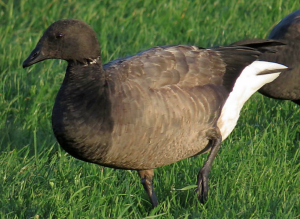
Barnacle Geese
Barnacle geese (Branta leucopsis) are medium sized sociable geese, with a dark neck and upperparts contrasted with a white belly and face. They feed on grasses and their seeds and roots and overwinter in the harbour after breeding high up on the Arctic cliffs of Svalbard. Their gosling’s terrifying leaps of faith were captured by the BBC Earth team for the series Life Story. Try looking at Swineham Gravel Pits, Holmebridge, Brands Bay and Bestwall for a chance to see Barnacle Geese, although their occurrence in Poole Harbour is only very sporadic with flocks appearing once every couple of years. Keep an eye out for any unusual looking geese accompanying them as hybrids have been seen hanging out with Barnacle geese at Swineham!
Barnacle geese can be remembered as the black and white geese as ‘Branta’ means black and ‘leucopsis’ means white.
Barnacle Geese – Swineham GP, Oct 2017 – Paul Morton
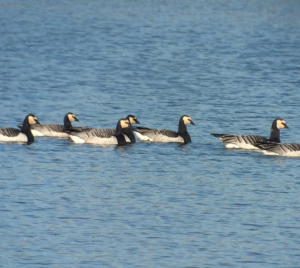
Pink-footed Geese
Pink-footed geese (Anser brachyrhynchus) are medium sized geese. They are characterised by grey upperparts, a brown breast, belly and neck and pink legs and feet. A pink lateral band can be seen on their dark bills. They feed on grains, grass and winter cereals and are overwintering from Svalbard, Iceland and Greenland.
Pink-footed geese are Britain’s most numerous wintering goose but are much rarer on the south coast than in Scotland and the north and east of England. Best times to see this scarce visitor is between November and January in the Frome Valley and Holmebridge floodplains. Let us know if you spot one – the average record for Pink-footed Geese sightings is 1 or 2 bird every 1 to 2 years.
Pink-footed Goose (left) – Holmebridge, Oct 2017 – Kevin Lane
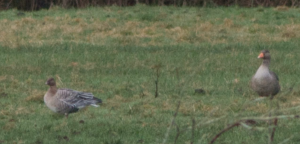
Bean Geese
Bean Geese (Anser serrirostris) are large to medium sized geese. They can be easily confused with Pink-footed Geese, and historically have been considered the same species. However, where the Pink-footed Goose beak is pink the Bean goose is orange with bright orange legs and feet and an orange lateral band on the bill. Though distinct in good lighting, the soft rosy glow of winter dawn and dusk could show pink legs as orange or vice-versa.
Cold snaps in Russia will trigger small groups (<10) of Bean Geese to escape to the comparatively warmer UK and so they are a much rarer sight on our shores. Just two Bean Geese were found in 2014 which is the last known record. Your best chances of catching a sighting of these scarce visitors are Frome valley, Swineham Gravel Pits and Bestwall.
Bean Geese – Swineham GP, Dec 2014 – Joe Mitchell
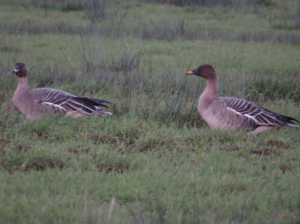
White-fronted Geese
White-fronted Geese (Anser albifrons) are grey medium sized geese characterised by orange legs and bills and a large white patch surrounding the bill on the front of the head. The race of White-fronted Goose most likely to grace our shores are those from Greenland, just like those visiting Abbotsbury earlier in the week. The Siberian race can be distinguished with pink bills, as opposed to orange. They feed on grasses, grains and winter wheat.
Small flocks used to occur in the harbour most winters but usually only for a brief period. Though they used to be semi-annual visitors they have become relatively scarce. There have been no sightings in the harbour in the last five years!
White-fronted Geese – Bestwall, Jan 2011 – Neil Gartshore
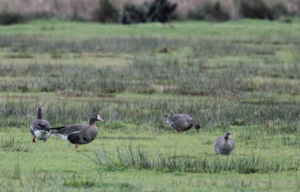
Greylag Geese
Greylag Geese (Anser anser) is the largest of our native geese and characterised with a grey-brown body, buff breast, orange bill and pink legs. They feed on grasses, cereals and grains. This bulky goose is the ancestor of our domesticated geese. Its Latin name translates to the rather uninspired ‘Goose goose’.
Those familiar with Poole Park will be well acquainted with the sizeable and semi-tame feral population there. They are often mixed with Canada geese. In winter however, Greylag numbers are augmented with migrants from Northern Europe. They make their way over to sites along Frome valley.
Greylag Goose – Poole Park, Oct 2017 – Neale Smith
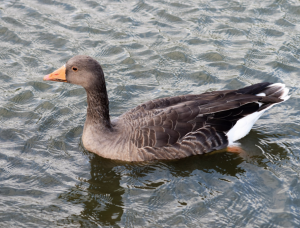
Canada Geese
Canada Geese (Anser canadensis) are the only non-native species in our harbour line-up. This rather conspicuous large goose is characterised with a brown body, buff breast, a long black neck and legs and a prominent white chinstrap.
Numbers peak in August with the emergence of youngsters following breeding. Large groups can be found in Poole Park mixed with the resident Greylag geese. In winter, Canada geese will roost in the harbour and visit local farmlands to feed on grasses and cereals.
Canada Goose – Lytchett Fields, Dec 2017 – Ian Ballam

The first rain for a couple of weeks today was quite welcome with lots of the river valleys…
Find out moreWith the sun finally deciding to hide behind some cloud today, it was a slightly chillier (and more…
Find out more© 2025 Birds of Poole Harbour Registered Charity No. 1152615